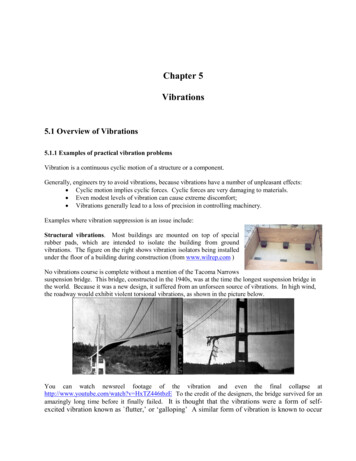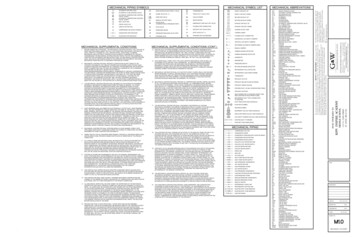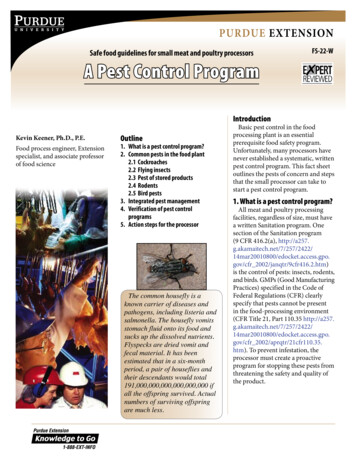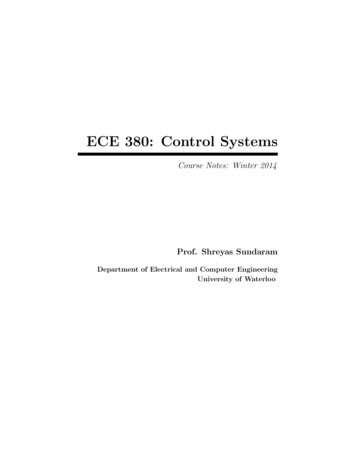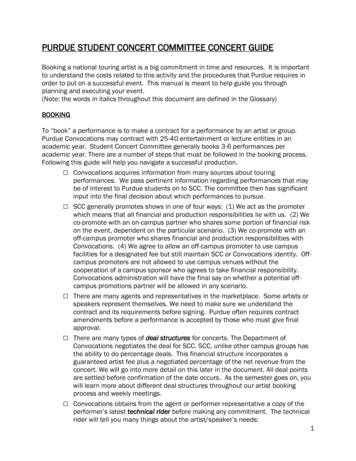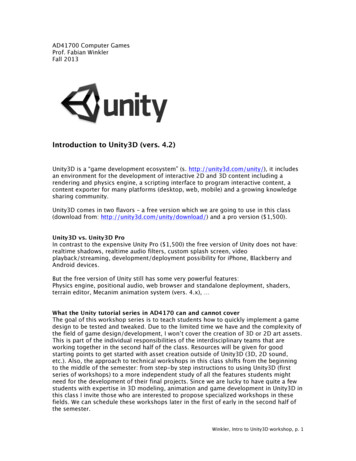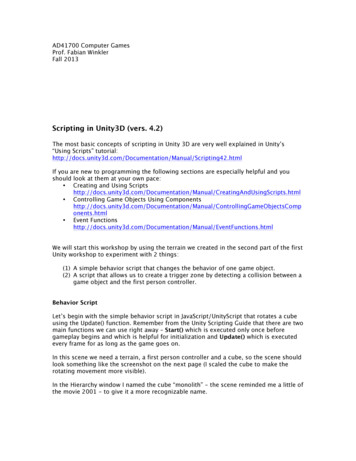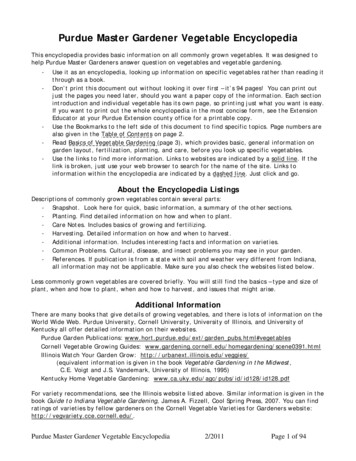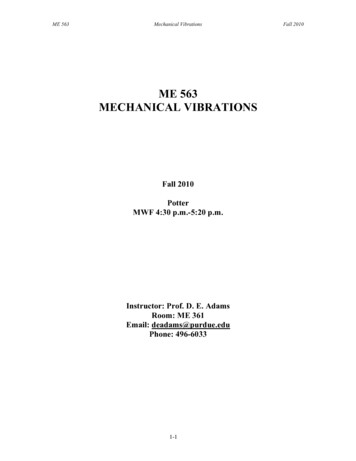
Transcription
ME 563Mechanical VibrationsME 563MECHANICAL VIBRATIONSFall 2010PotterMWF 4:30 p.m.-5:20 p.m.Instructor: Prof. D. E. AdamsRoom: ME 361Email: deadams@purdue.eduPhone: 496-60331-1Fall 2010
ME 563Mechanical VibrationsFall 20101 Introduction to Mechanical Vibrations1.1Bad vibrations, good vibrations, and the role of analysisVibrations are oscillations in mechanical dynamic systems. Although any system can oscillatewhen it is forced to do so externally, the term “vibration” in mechanical engineering is oftenreserved for systems that can oscillate freely without applied forces. Sometimes these vibrationscause minor or serious performance or safety problems in engineered systems. For instance,when an aircraft wing vibrates excessively, passengers in the aircraft become uncomfortableespecially when the frequencies of vibration correspond to natural frequencies of the human bodyand organs. In fact, it is well known that the resonant frequency of the human intestinal tract(approx. 4-8 Hz) should be avoided at all costs when designing high performance aircraft andreusable launch vehicles because sustained exposure can cause serious internal trauma(Leatherwood and Dempsey, 1976 NASA TN D-8188). If an aircraft wing vibrates at largeamplitudes for an extended period of time, the wing will eventually experience a fatigue failure ofsome kind, which would potentially cause the aircraft to crash resulting in injuries and/orfatalities. Wing vibrations of this type are usually associated with the wide variety of flutterphenomena brought on by fluid-structure interactions. The most famous engineering disaster ofall time was the Tacoma Narrows Bridge disaster in 1940 (see Figure 1.1 below). It failed due tothe same type of self-excited vibration behavior that occurs in aircraft wings.Figure 1.1: (left) View of Tacoma Narrows Bridge along deck; (right) view of torsionalvibrationIn reading books and technical papers on vibration including the previous paragraph,engineering students are usually left with the impression that all vibrations are detrimentalbecause most publicized work discusses vibration reduction in one form or another. But1-2
ME 563Mechanical VibrationsFall 2010vibrations can also be beneficial. For instance, many different types of mining operations rely onsifting vibrations through which different sized particles are sorted using vibrations. In nature,vibrations are also used by all kinds of different species in their daily lives. Orb web spiders, forexample, use vibrations in their webs to detect the presence of flies and other insects as theystruggle after being captured in the web for food. The reason that mechanical systems vibratefreely is because energy is exchanged between the system’s inertial (masses) elements and elastic(springs) elements. Free vibrations usually cease after a certain length of time because dampingelements in systems dissipate energy as it is converted back-and-forth between kinetic energy andpotential energy.The role of mechanical vibration analysis should be to use mathematical tools for modelingand predicting potential vibration problems and solutions, which are usually not obvious inpreliminary engineering designs. If problems can be predicted, then designs can be modified tomitigate vibration problems before systems are manufactured.Vibrations can also beintentionally introduced into designs to take advantage of benefits of relative mechanical motionand to resonate systems (e.g., scanning microscopy). Unfortunately, knowledge of vibrations inpreliminary mechanical designs is rarely considered essential, so many vibration studies arecarried out only after systems are manufactured. In these cases, vibration problems must beaddressed using passive or active design modifications. Sometimes a design modification may beas simple as a thickness change in a vibrating panel; added thickness tends to push the resonantfrequencies of a panel higher leading to less vibration in the operating frequency range. Designmodifications can also be as complicated as inserting magneto-rheological (MR) fluid dampersinto mechanical systems to take energy away from vibrating systems at specific times during theirmotion. The point here is that design changes prior to manufacture are less expensive and moreeffective than design modifications done later on.1.2Modeling issuesModeling is usually 95% of the effort in real-world mechanical vibration problems; however, thiscourse will focus primarily on the derivation of equations of motion, free response and forcedresponse analysis, and approximate solution methods for vibrating systems. Figure 1.2 illustratesone example of why modeling can be challenging in mechanical vibrating systems. A large craneon a shipping dock is shown loading/unloading packages from a cargo ship. In one possiblevibration scenario, the cable might be idealized as massless and the crane idealized as rigid. In1-3
ME 563Mechanical VibrationsFall 2010this simple case, the package and crane both oscillate as rigid bodies; the package oscillates aboutthe end of the crane and the crane oscillates about its base point of rotation as the two exchangeenergy. These vibrations would most likely correspond to relatively low frequencies and wouldtake place in addition to the gross dynamical motion of the crane and package. Two coupledordinary differential equations would be needed in this case to model the discrete, independentmotions of the crane and package.This model might be sufficient in some cases, but what if the mass of the cable is comparableto the mass of the package? In this case, the crane and package still behave like rigid bodies, butthe cable will probably vibrate either transversely or longitudinally as a continuous body along itslength. These higher frequency vibrations would require that both ordinary differential equationsfor the crane and package and partial differential equations of the cable be used to model theentire system. Furthermore, if the assumption of rigidity in the crane were also relaxed, then ittoo would need to be modeled with partial differential equations. All of these complicationswould be superimposed on top of the simple rigid body dynamics of the crane and package.Figure 1.2: Crane for loading/unloading packages from cargo ship. Different regimes ofoperation require different levels of sophistication in the mechanical vibration model.We will have the opportunity to discuss modeling considerations throughout the course whencase studies of vibration phenomena are used to reinforce theoretical concepts and analysisprocedures. Before starting to analyze systems, we must be able to derive differential equations1-4
ME 563Mechanical VibrationsFall 2010of motion that adequately describe the systems. There are many different methods for doing this;these are discussed in Chapter 2.1.3Linear superposition as a “working” principleWe cannot discuss everything in this course. In particular, there is not sufficient time to presentlinear and nonlinear methods of vibration analysis. Therefore, the course will primarily focus onlinear vibrating systems and linear approaches to analysis. Only certain special characteristics ofnonlinear systems will be introduced during the semester. Because the decision has been made totalk primarily about linear systems, the principle of superposition will hold in every problem thatis discussed. Instead of stating this principle at the beginning of the course, and referencing itwhen it is needed in proofs and derivations, we will view it more as a “working” principle. Inother words, linear superposition will guide us in our analysis of free and forced linear vibrations.When we begin to analyze vibrations, we will look to the principle of superposition to help usmove forward in our analyses. Recall that a mathematical operator, L[ ], which obeys theprinciple of linear superposition by definition satisfies the following two expressions:( 1.1 )and( 1.2 )where L is said to operate on the two different functions, x and y, and a and b are constants. Eq.( 1.1 ) is the principle of homogeneity and Eq. ( 1.2 ) is the principle of additivity. These twoexpressions may seem trivial or obvious, but they will in fact be extraordinarily useful later in thecourse. The important point to remember is that linear systems, which are governed by linearoperators, L[ ], are equal to the sum of their parts. Although this statement is profound and mayeven be fruit for philosophical discussions, the motivation for putting linear vibration into thecontext of linear superposition here is that it makes vibration analysis in free and forced systemsmuch easier to develop and understand. More will be said about superposition in Chapter 3.1-5
ME 5631.4Mechanical VibrationsFall 2010Review of kinematics and generalized coordinate descriptionsThis section will review some of the fundamental techniques in particle kinematics. Note thatthis is only a review so no attempt is being made to cover everything here. Student should takethis opportunity to refresh their memories of undergraduate courses in mechanics. Generalizedcoordinates are the basis for our kinematic description of vibrating bodies.Generalizedcoordinates are usually either position variables (e.g., x, y, z, and r), angular variables (e.g., φ, θ,and α), or a combination thereof (e.g., rcosφ). We must choose our set of generalized variables ineach problem to adequately describe the position and orientation of all bodies in the mechanicalsystem of interest. Note that the position and orientation are both important because both of thesecoordinates are associated with kinetic and potential energy storage. The minimum number ofcoordinates required is equal to the degrees-of-freedom (DOFs). Sometimes the number of DOFsis not obvious.For example, Figure 1.3 illustrates a pendulum-cart system that has manytranslating and rotating inertias.The question is:How many generalized coordinates arerequired to locate and orient all of the inertias?Figure 1.3: Mass-spring-damper-pendulum cart systemIn order to locate and orient every body, it appears as if one coordinate is needed for M1, onecoordinate for M2, one coordinate for M3, two coordinates for M4, and two coordinates for M5: atotal of seven coordinates are needed. But all of these coordinates are not actually requiredbecause there are some constraints between them. First, the translation of M3 is equal to the1-6
ME 563Mechanical VibrationsFall 2010motion of the center-of-mass of M4. Second, the translation of M4 is proportional to its rotation,x4 R4θ4. Third, the translation of M5 is equal to the translation of M2 plus a component due to therotation of M5. With a total of three constraints, the number of DOFs is reduced as follows:Simply put, this statement implies that there should be four differential equations of motion forthis system. The first step in any analytical vibrations problem should be to compute the numberof DOFs. As an aside, the number of DOFs (i.e., ½ the order of the system) must also always beestimated prior to applying experimental vibration techniques.There are many different common sets of generalized coordinates in use for mechanicalvibration analysis. If a position vector, r, of a particle (or center-of-mass) is written in terms ofits associated generalized (possibly) curvilinear coordinates, qi , as follows:( 1.3 )then the differential tangent vector, dr, is given by,( 1.4 )where the generalized coordinate unit vectors, ek, are given in parenthesis in the second of theseequations and are chosen to be orthogonal in most vibration problems, and the hkk are scalefactors associated with the generalized coordinate differentials, dqk. For example, the cylindricalcoordinate system in terms of the Cartesian coordinate unit vectors is given by,1-7
ME 563Mechanical VibrationsFall 2010( 1.5 )so the differential position vector is,( 1.6 )with the following scale factors and orthogonal unit vectors:( 1.7 )The fundamental theorem of kinematics can now be used to compute the velocity vector directly(this equation is used later when computing velocity vectors for the kinetic energy terms). Thegeneral and specific forms (cylindrical coordinates) of the velocity, dr/dt, are given below:( 1.8 )There are other useful closed-form expressions for kinematic variables like acceleration, forexample, which provide insight into various methods for deriving equations of motion in the nextchapter. Moreover, we will see later that the acceleration in the ek direction can be computed asfollows:( 1.9 )1-8
ME 563Mechanical VibrationsFall 2010which fits directly into Lagrange’s approach for deriving differential equations of motion.The important point to note here is that we must be able to describe how bodies move inorder to derive physical equations of motion.Kinematics is the first essential element ofvibration analysis. In the next chapter, methods for combining the kinematics and physics usingNewtonian (vectorial) methods and analytical methods (e.g., energy/power, Lagrange) arediscussed.1.5Review of energy and power expressionsThis section will review some important ideas in energy and power in mechanical systems. Theseideas are important because we will use analytical energy methods in many problems to deriveequations of motion for vibrating systems. If an increment of mechanical work on a particle ofmass M is denoted as ΔW, then this amount of work can be calculated using the force applied tothe particle along the incremental change in path, dr, of the particle as follows:( 1.10 )where the denotes a dot product between the force and differential displacement vector. Notethat the incremental amount of work is a scalar. Scalar quantities like this one will be used inChapter 2 to develop elegant methods for deriving complicated equations of motion. Because thekinetic energy, T, of a particle is equal to the rate of change in ΔW with time, a convenientexpression for T
context of linear superposition here is that it makes vibration analysis in free and forced systems much easier to develop and understand. More will be said about superposition in Chapter 3. ME 563 Mechanical Vibrations Fall 2010 1-6 1.4 Review of kinematics and generalized coordinate descriptions This section will review some of the fundamental techniques in particle kinematics. Note that .
